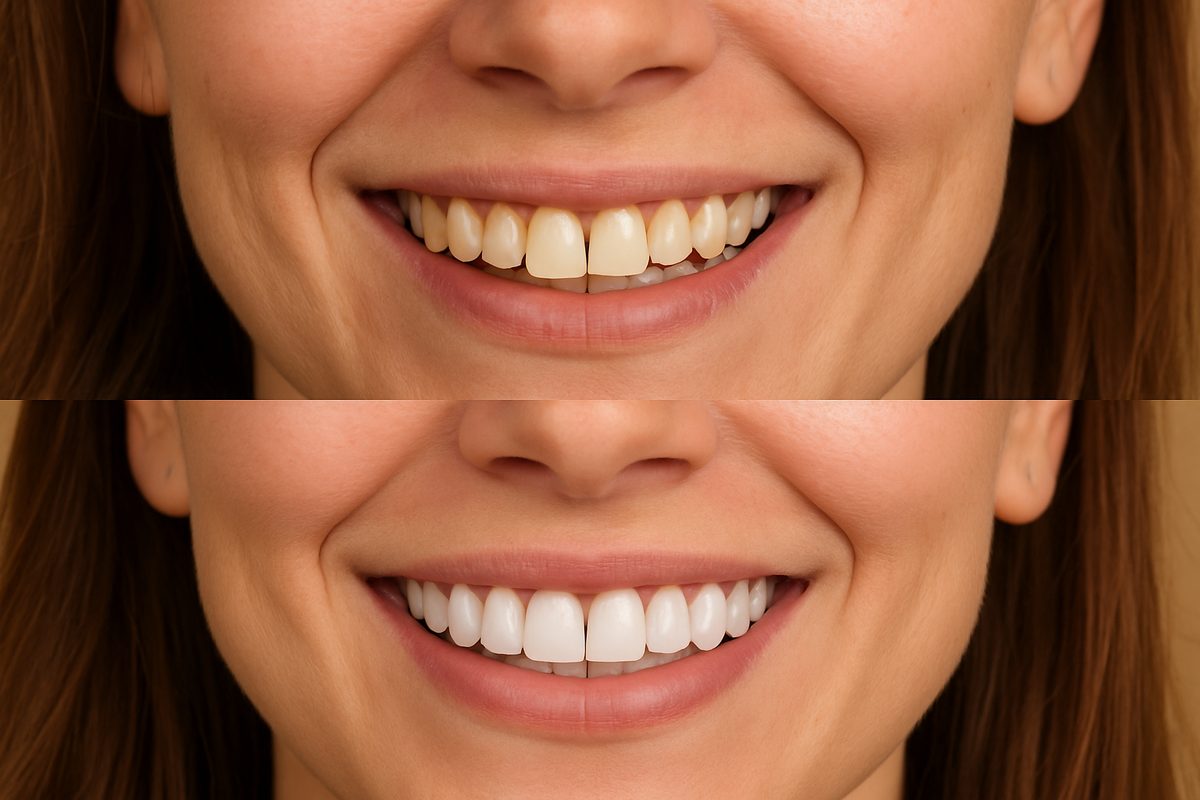“Teeth over teeth” refers to using porcelain veneers placed over your existing teeth to change their shape, color, or alignment. People who consider “teeth over teeth” are usually looking for a cosmetic upgrade—stains, gaps, small chips, or mild alignment issues—without major dental surgery. This guide explains what porcelain veneers are, who is a good candidate, the step-by-step process, benefits and drawbacks, alternatives, care and cost expectations, common risks, and how West Dentistry in Jacksonville can help you explore this option.
What “Teeth Over Teeth” Means: Porcelain Veneers Explained
Porcelain veneers are thin shells of ceramic bonded to the front surface of teeth. The phrase “teeth over teeth” highlights that veneers sit on top of your natural teeth rather than replacing them. Veneers differ from crowns, which cover the whole tooth, and from bonding, which uses composite resin built up on the tooth. Compared to implants, veneers do not replace missing teeth. Porcelain is favored because it mimics natural enamel, resists stains, and can be shaped precisely for a cosmetic result with minimal tooth removal when compared to crowns.
Who Is A Good Candidate For “Teeth Over Teeth” Veneers?
Good candidates for “teeth over teeth” veneers in Jacksonville are adults with healthy gums, sufficient enamel, and reasonable bite alignment. Typical candidates want to fix discoloration, worn edges, small gaps, or minor crowding. Veneers are not recommended if you have severe tooth decay, active gum disease, very little enamel, or heavy teeth grinding (bruxism) that could damage the veneers. In those cases, your dentist may suggest crowns, orthodontics, or implants instead.
The “Teeth Over Teeth” Veneer Process — Step By Step
Consultation And Digital Planning
The process starts with a consultation and digital planning. Your dentist will take photos, X-rays, and intraoral scans to study your bite and tooth shape. Digital mockups and smile design let you preview “teeth over teeth” results before work begins. This step identifies whether veneers are the right choice and maps the shade and shape of the final teeth.
Tooth Preparation And Impression
To prepare for veneers, a thin layer of enamel (often 0.3–0.7 mm) is removed to make room for the porcelain. The amount removed is minimal compared to crowns. Then the dentist takes a digital impression or traditional mold. These records are sent to a dental lab or used with in-house CAD/CAM milling to fabricate the porcelain shells.
Temporary Veneers And Final Bonding
Temporary veneers may be placed while the final pieces are being made. At the try-in appointment, the dentist checks fit, color, and bite, making any adjustments. Once you and the dentist approve the look, the porcelain veneers are permanently bonded to your teeth with special dental cement and polished for a natural finish.
Benefits And Drawbacks Of “Teeth Over Teeth” Porcelain Veneers
- Benefits: Natural appearance, strong stain resistance, quick smile transformation, and conservative compared with full crowns.
- Drawbacks: Requires irreversible enamel removal, cost can be high, potential for sensitivity after preparation, and may need replacement after 10–15 years.
Alternatives To “Teeth Over Teeth” Veneers
Consider other options depending on your needs. Clear aligners can correct alignment without removing enamel. Cosmetic bonding is a less expensive option for small chips or gaps but stains more easily. Crowns are better when a tooth is structurally weak or heavily restored. Dental implants replace missing teeth and are the functional choice when a tooth cannot be saved. Your dentist will recommend the best approach based on function and appearance.
Care, Longevity, And Cost Expectations For “Teeth Over Teeth” Veneers
With good care—brushing twice daily, flossing, and regular dental checkups—porcelain veneers commonly last 10–15 years. Avoid biting hard objects and limit staining foods and tobacco to keep veneers looking their best. Signs of failure include chips, loosening, or dark lines at the gum. Cost depends on the number of veneers, lab quality, and any preparatory work; higher-quality ceramics and custom design increase price but usually yield more natural, long-lasting results.
Potential Risks And How To Minimize Them
Risks include temporary sensitivity after enamel removal, veneer fracture, and gum irritation. Proper occlusal (bite) assessment lowers the risk of fractures. If you grind your teeth, a night guard can protect veneers. Choosing an experienced cosmetic dentist, using high-quality materials, and following aftercare instructions reduce most risks.
Is “Teeth Over Teeth” Right For You? How West Dentistry Helps
If you’re considering “teeth over teeth” in Jacksonville, West Dentistry offers digital imaging, intraoral scanning, and a team approach to plan predictable results. Dr. Jacqueline West and the staff use modern materials and digital mockups so you can see proposed changes before treatment starts. Financing and online scheduling are available to help you take the next step.
Ready to see a digital mockup and learn if “teeth over teeth” porcelain veneers are right for you? Schedule a consultation online or contact West Dentistry’s patient resources to book your visit and review financing options.

